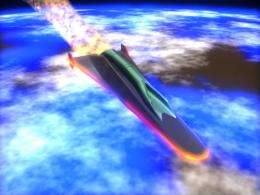New materials designed to deal with hypersonic and supersonic hot stuff (w/ Video)

University of Queensland researchers are testing new materials to withstand the extreme heat experienced by hypersonic vehicles in flight so they can fly for substantially longer.
Previous Australian experimental flight tests of scramjets, a type of very fast jet engine, have not lasted longer than five seconds.
The tests, conducted at Woomera in South Australia over the past eight years, have used scramjet engines made of conventional materials which have problems with extreme heat including melting, and are not designed for re-use.
However, further experimental tests are planned in 2011 through to 2013 in the HiFIRE series at Woomera using free-flying engines and eventually, a whole free-flying vehicle which will generate enough thrust to fly for a minute.
The leader of UQ's Hyshot scramjet experiment program and UQ Professor in Hypersonic Propulsion, Professor Michael Smart said the project was testing new composite materials for the longer flights at Mach 8 (eight times the speed of sound).
“If they can fly for a minute, they can fly for an hour,” he said.
“A scramjet-powered vehicle could fly between London and Australia in two hours so we're looking at materials that can survive hypersonic speeds for longer periods.”
[Hypersonics is the study of flight speeds faster than Mach 5 (five times the speed of sound or more than twice as fast as the Concorde). Supersonic speed is greater than Mach 1, while modern commercial airliners fly below the speed of sound. ]
Professor Smart said the research was particularly looking at new materials for leading edges, the parts of the wings that first contact the air.
In high speed aircraft, air friction can cause extreme heating of the leading edge — temperatures on the surface of an object travelling at Mach 5 can reach 1000 degrees C (1800 deg F). These high temperatures can not be sustained by most materials.
Another challenging problem area is inside the scramjet engine, which must handle a corrosive mix of hot oxygen and combustion products, as well as high thermal, mechanical and acoustic loadings.
At higher speeds the temperatures can be even more extreme — for example at Mach 8 the temperatures can reach 2700 degress C at the leading edge and 3000 degrees C in the engine combustion chamber.
Extreme heating of the leading edge was the cause of the Space Shuttle Columbia accident during re-entry in 2003. The accident was preceded by damage to protective tiles on the leading edge which occurred during takeoff.
Professor Smart said hypersonic propulsion heating problems could be overcome through the selection of materials, as well as design and cooling arrangements.
He is working with ceramic composite materials pioneer Professor John Drennan, Director of UQ's Centre for Microscopy and Microanalysis, and postdoctoral researchers Dr James Turner and Dr Anna Lashtabeg on the current project. Student David Yu (School of ITEE,eResearch Centre) has prepared animations showing processes occurring at extreme temperatures.
Professor Drennan is looking at a number of concepts to enable hypersonics vehicles to handle extreme heat for prolonged periods.
One of the concepts that is looking promising is to design materials which ablate at high temperature.
However, unlike the usual systems where material is lost to the surroundings, this new material is able to replenish the lost material through microstructural design.
“The technologies we are developing will have application anywhere where performance is needed from materials in high temperature environments for long periods,” he said.
“Some potential uses for the new materials might include in power plants and for exhaust nozzles of jet engines.”
Professor Drennan said the technologies developed would benefit Australian industry by providing further capabilities in materials science.
“Australian industries will be able to build components of aircraft, rather than having to import these materials from the U.S. and Europe,” he said.
Provided by University of Queensland
















